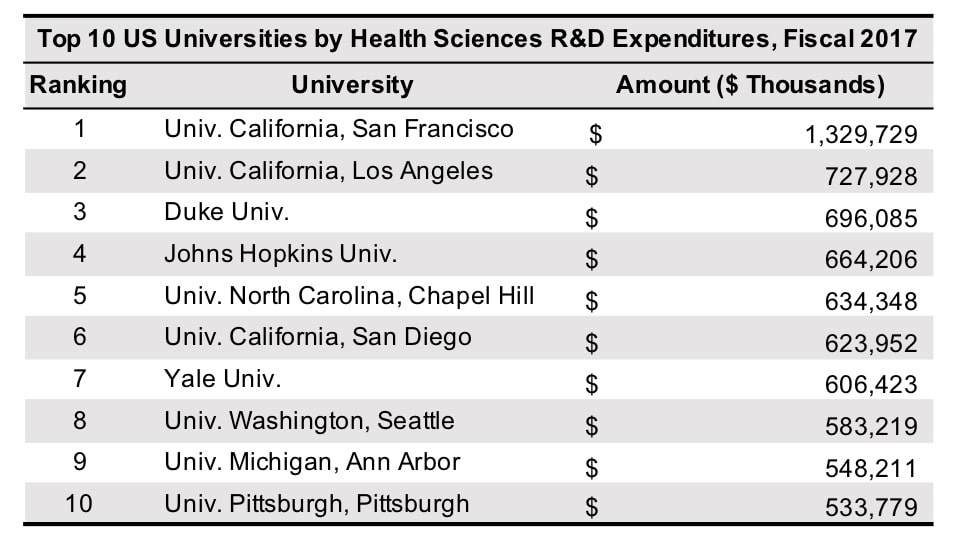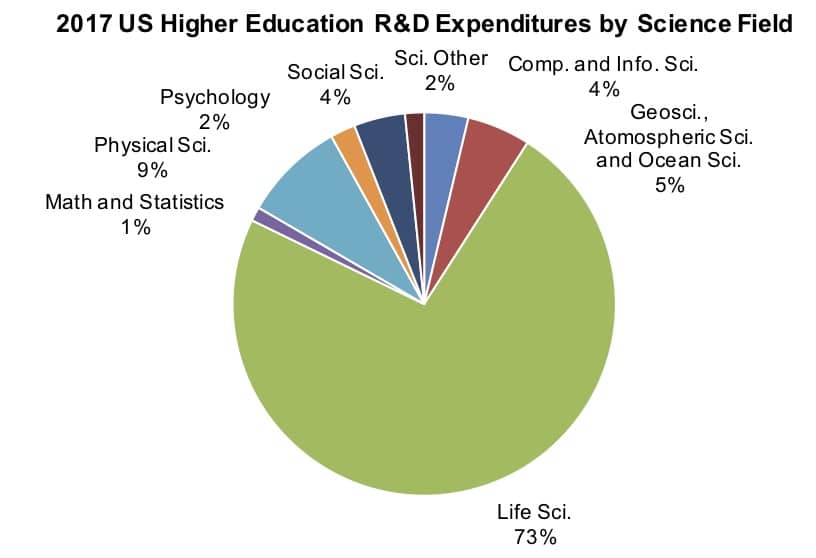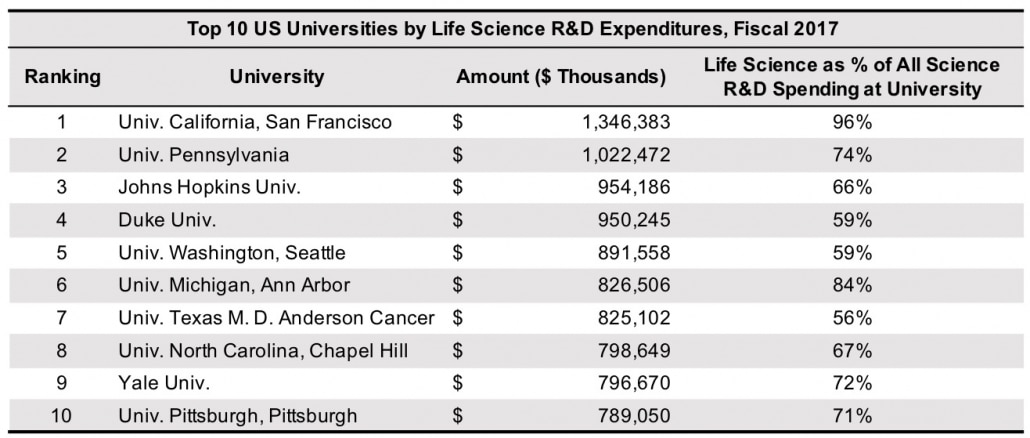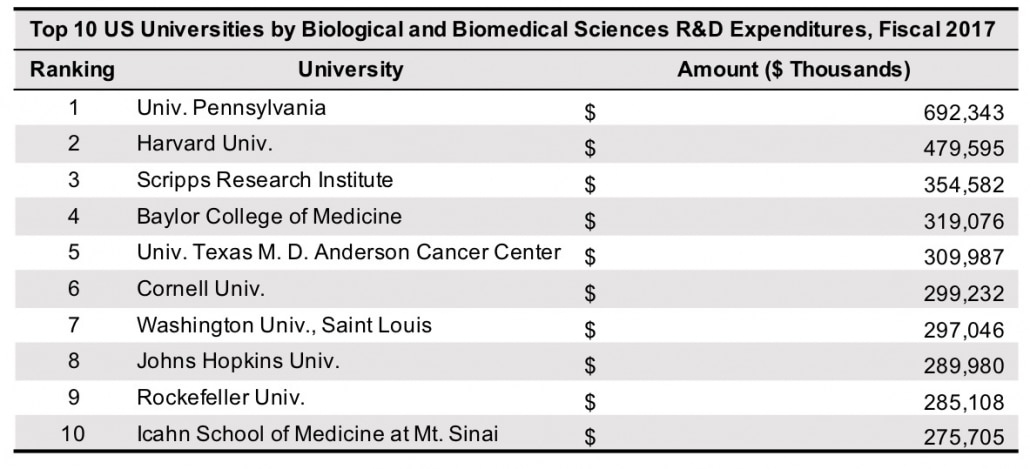US Life Science R&D and Higher Education
Universities are an important source of health sciences and biological sciences R&D spending, two fields which make up the majority of life science R&D spending in the US. In fiscal 2017, university spending in both fields totaled $37.7 billion, a 6.4% increase, to make up 64% of all university science R&D spending. Within each field, spending is concentrated at key universities.
Providing greater insight into such spending was the release this month of the National Science Foundation’s (NSF) latest statistical report tracking science and engineering R&D spending in the US. The “Higher Education Research and Development Survey Fiscal Year 2017” report is based on a survey of US higher education institutions that spent a minimum of $150,000 on R&D in the last academic fiscal year (ending June 30 2017). A total of 903 institutions responded to the survey, which was conducted between November 2017 and June 2018.
The Lion’s Share: Life Sciences
By far, life sciences is the largest scientific field for university R&D spending. Among the eight science R&D fields examined in the survey (see pie chart below), life sciences accounted for nearly three-quarters of R&D spending by universities in fiscal 2017, or $59 billion, a 4.7% increase from the prior year. Federal government funding underpinned this spending, accounting for 53% of the total.
Among universities engaging in life sciences R&D, a handful outspent all others. In fact, two universities, the University of California, San Francisco (UCSF) and the University of Pennsylvania, each spent over $1 billion on life sciences R&D in fiscal 2017. Both universities are highly focused on R&D in the life sciences, with the field accounting for 95% and 74% of all science R&D spending at the respective schools that year.
The schools are examples of the concentration of life sciences R&D expenditures among a distinct number of universities. In total, the top 10 universities for life sciences R&D spending (see table below) accounted for 21% of the total in fiscal 2017 by the 624 universities in the survey that reported such spending. However, the top 10 universities’ commitment to life sciences R&D versus other fields is substantial, as 5 of the schools in the top 10 spent more than 70% of their science R&D expenditures in this one field.
The Life Sciences Leader: Health Sciences
The spending power of certain universities for life sciences R&D is further evident in the breakdown of the numbers for two fields: health sciences, and biological and biomedical sciences. Of the five categories classified as life sciences in the survey (see pie chart below), health sciences accounted for the largest share of university life sciences R&D spending in fiscal 2017 at 56%, or $24.0 billion. UCSF easily out performed its peers in terms of spending as it is wholly focused on health sciences. Such spending made up 98% of all life sciences R&D expenditures by the school.
However, UCSF is not alone as a health sciences R&D powerhouse. The top 10 universities (see table below) dominated such spending, accounting for 29% of all health sciences R&D expenditures by higher education institutions in fiscal 2017. Even more concentrated, the top 20 accounted for 47%.

Source: NSF
Click to enlarge
Despite this ratio, spending increases for both groups of universities were nearly equivalent in fiscal 2017. Health sciences R&D expenditures for the top 10 grew 6.2% compared to 6.9% increase for all other universities. In addition, both sets of universities received nearly the same percentage of federally financed support for health sciences R&D. In fiscal 2017, the percentage was 54% for the top 10 and 52% for all other universities.
A Slightly Different Story: Biological and Biomedical Sciences
At 32%, or $13.7 billion, biological and biomedical sciences was the second largest field for university life sciences R&D funding in fiscal 2017. As in the health sciences, spending by the top 10 universities (see table below) accounted for a disproportionately large share of the total, representing 26%. However, compared to health sciences R&D, spending is less concentrated among the top 20 universities, which represented only 33% of the total.
As with the health sciences, one university’s expenditures clearly topped all others. The University of Pennsylvania’s spending in biological and biomedical sciences outdistanced other universities. However, the school’s life sciences R&D was not solely focused on biological and biomedical sciences, as such funding accounted for 60% of its total R&D expenditures for life sciences.
R&D expenditures for biological and biomedical sciences increased for both the top 10 and other universities in fiscal 2017. As with the health sciences, other universities’ spending outpaced that of the top 10, but at a wider margin, rising 5.5% compared to 3.8%, respectively. However, other universities were more dependent than the top 10 universities on federal financing for biological and biomedical R&D, receiving 77% of all federal funding versus 23% for the top 10.
With life sciences expected to continue to dominate university science R&D spending in the years to come, health sciences in particular can be expected be a focus for R&D spending by universities, with a subset of universities driving such expenditures.









